This remarkable gramophone is powered by a hot-air engine instead of the usual clockwork. It was found at the National Gin Museum in Hasselt, Belgium. The link is that the engine is heated by burning alcohol, though not, I assume, gin. It was called "The Maestrofoon", and according to the label on the case, was made by Paillard in Switzerland, around 1915.
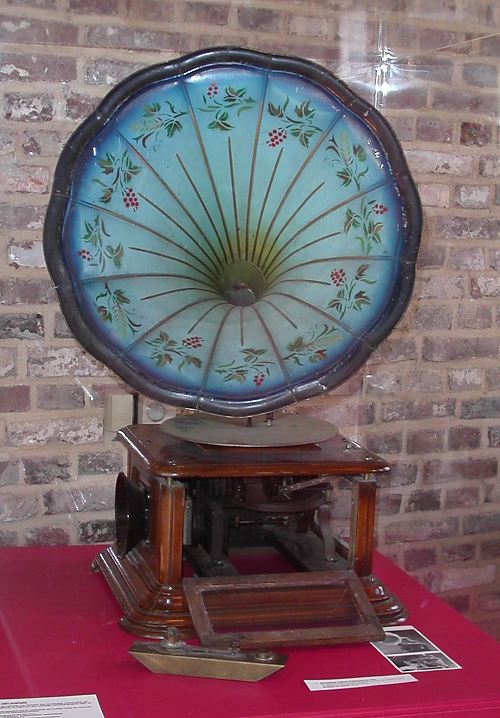 |
| Left: The Maestrofoon in all its glory.
The engine compartment has a hinged door to allow access to the burner, which is the boat-shaped brass object in the foreground. Fuel consumption was about one pint of methylated spirit per hour. The wick (missing its vapourising cap) is on the left and the filler on the right.
The black funnel to the left is not a tweeter. It is simply an exhaust for the burner fumes.
The cabinet is of polished oak.

You can now see and hear The Maestrofoon for yourself; Rene Rondeau has put a video on Youtube.
Go to www.youtube.com/user/ReneRondeau (external link) and select the "Antique Phonograph with Stirling Engine Hot Air Motor" video.
There is now another video available at www.dailymotion.com/bdeschabis which shows a great deal more about the internal construction and operation of these machines, and reveals that the the hot-air engine is of the alpha Stirling type. The alpha configuration has two cylinders: one has a hot and a cold end and contains the displacer, and the other cylinder has cooling fins and contains the power piston. There are also beta and gamma confgurations.
|
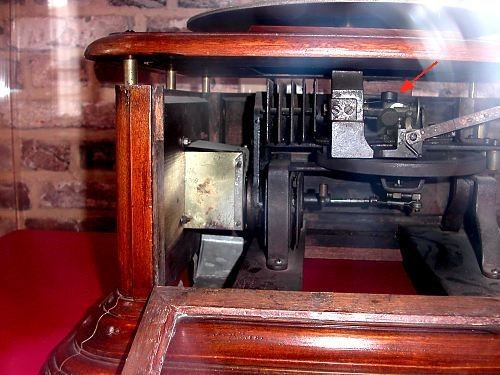 |
| Left: The engine-room of The Maestrofoon.
The vertical iron plates appear to be attached to the upper (power) cylinder. The red arrow points to the centrifugal speed governor.
Note the brass pillars that create an air gap in the casing, to let the heat escape from the engine compartment. There is a substantial flywheel visible just above the crank; this is 7 inches in diameter. Hot-air engines are not self-starting, so a tug on this was required to start it moving. The crankshaft had ball-bearings, and the drive train consisted of spur gears, then a belt driving the main turntable spindle. A friction-clutch operated by manipulating the central spindle of the turntable connected and disconnected the engine.
|
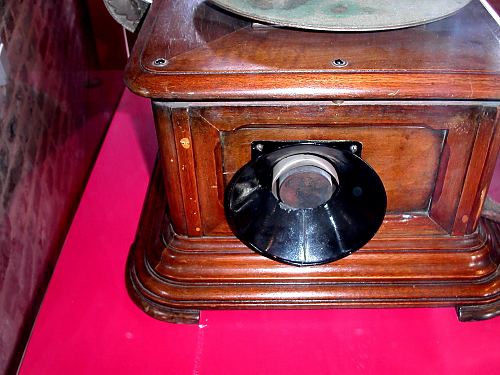 |
| Left: The enigmatic funnel of the Maestrofoon.
The discoloured metal in the middle looks like the end of a cylinder which has clearly been heated at some time, and the burner flame is visible through the bottom of the funnel. This appears to be the hot end of the displacer cylinder.
My research into hot-air engines is continuing. There's more to learn than you might think.
|
TECHNICAL DETAILS
I have found a source of information which states that the hot air engines were made in Liège, Belgium, and were originally intended for driving shop window displays. This also states that the engine had 3.2mm bore and 3.1mm stroke, which is clearly wrong. A 3.2cm bore and 3.1cm stroke seems to be what was meant, but since hot-air engines tend to have two pistons, this is still not too helpful.
THE HOT-AIR ENGINE
The classic Stirling hot air engine uses a displacer to move air from a heating zone to a cooling zone and back, and a power piston driven by the resulting expansion and contraction of the air. These are mechanically coupled so the power piston can drive the displacer.
However, it is possible to configure an engine so that the displacer moves by itself; this invention is usually credited to Ossian Ringbom; Ringbom-Stirling engine was first patented by Ossian Ringbom in 1908.
 |
| Left: A Maestrofoon
A lot of searching has revealed that there is at least one more of these devices around. This one was built by Paillard in 1910.
The air-gap between the top and sides for cooling is clearly visible.
|

HISTORY
The Swiss company of Paillard was established in 1814, and began by building musical boxes, before producing their first cylinder gramophone (the Échophone) in 1898. In 1904 they began building disc gramophones.
The Maestrofoon was first displayed at a fair in Liepzig in spring 1910. Several models were marketed, including the Benvenuto 206, the Poleucte 205, and the Appolo 10. Production seems to have ceased in 1914, so they had a short run. These gramophones cost about £5:00, which was a great deal of money at the time and considerably more expensive than a clockwork version.

ADVERTS
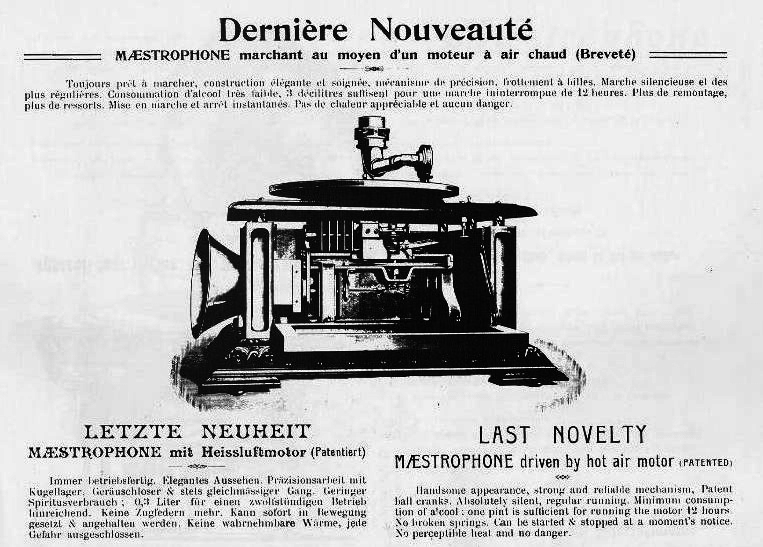 |
| Left: Maestrofoon/Maestrophone advert
This gives a view of the internals but it does not tell us much. Apparently there was a patent involved. 'Last Novelty' seems to be a mistranslation of 'Latest Novelty' though there was nothing new about hot-air engines at the time.
In the ad we are told that the hot-air engine will run for 12 hours on a pint of alcohol. If that was true, it seems very economical.
|
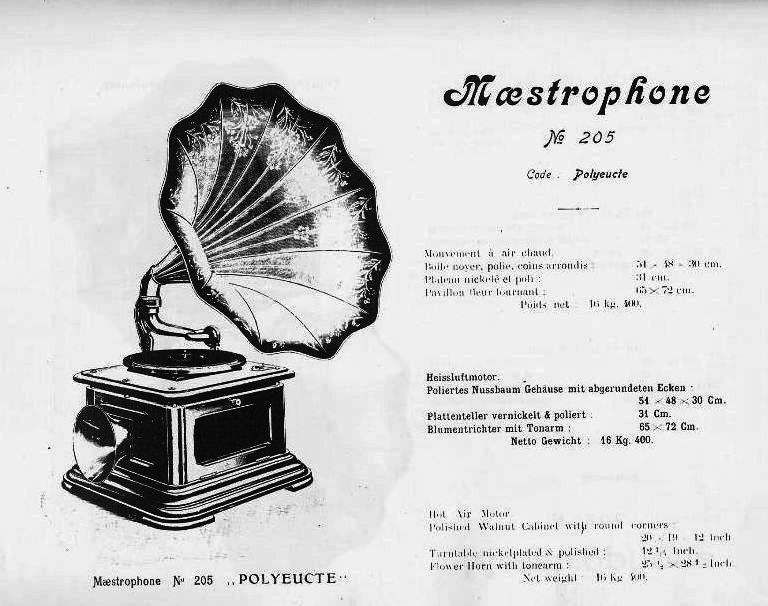 |
| Left: Maestrofoon advert for the Poleucte 205 model
This is an advert for the Polyeucte model. It weighs a hefty 16 kilograms.
Unfortunately there is no information about the hot-air engine.
|
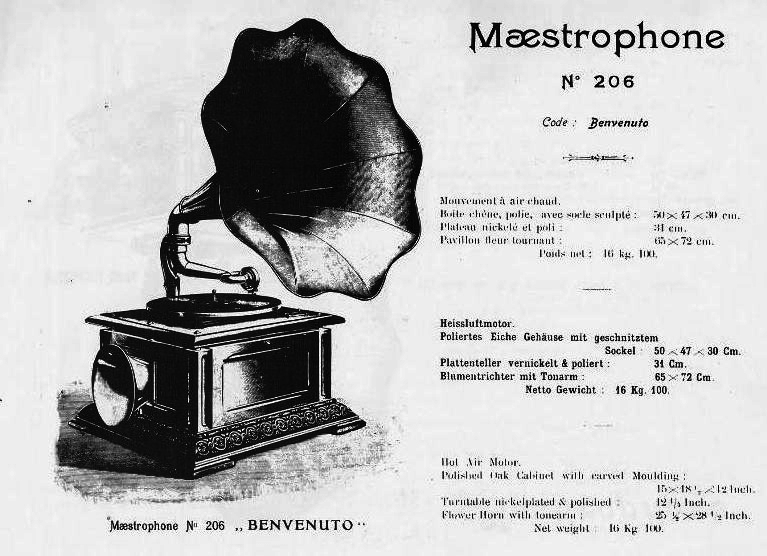 |
| Left: Maestrofoon advert for the Benvenuto 206 model
The Benvenuto seems to almost identical to the Polyeucte model.
|
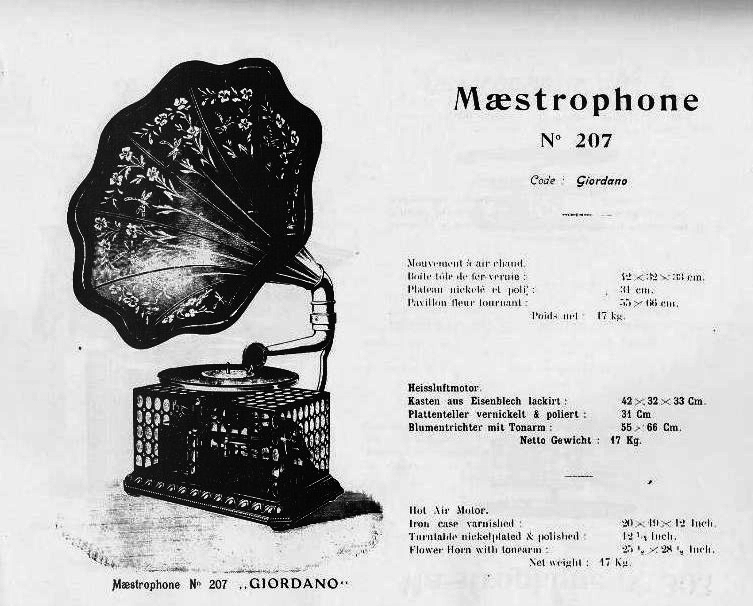 |
| Left: Maestrofoon advert for the Giordano 207 model
This unusual design has a varnished iron grid enclosure rather than a wooden cabinet. The idea behind this is obscure; perhaps the apparatus was prone to overheating in hot climates?
From the link at the end of the page:
"The fact is, after playing four 12" records, the fuel tank gets so hot that the alcohol starts to evaporate out of the breather hole faster than it can burn and runs dry. This and the overall level of internal case heat becomes precarious at best to continue longer."
There seems to some evidence that the Maestrophone was prone to catching fire, and this may have been a response to that.
|
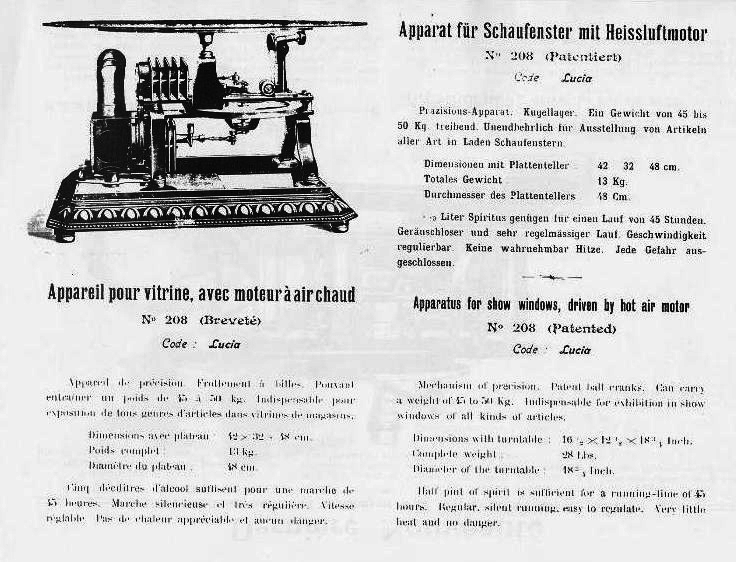 |
| Left: Hot-air engine for rotating shop-window displays: Model 208
This is very clearly the same hot-air engine as used for the gramophone, but there is a different exhaust duct that points out to the side. The crank for the displacer piston can be seen below the flywheel, and the crank for the power piston above the flywheel.
NB: Vitrine means a glass case or glazed shop window.
|
There is more information here
There is another Maestrophone video here.

Bibliography: Hot Air, Caloric and Stirling Engines. R Sier.


















